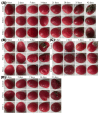Development and Characterization of Yeast-Incorporated Antimicrobial Cellulose Biofilms for Edible Food Packaging Application
- PMID: 34301067
- PMCID: PMC8309339
- DOI: 10.3390/polym13142310
Development and Characterization of Yeast-Incorporated Antimicrobial Cellulose Biofilms for Edible Food Packaging Application
Abstract
The unique properties and advantages of edible films over conventional food packaging have led the way to their extensive exploration in recent years. Moreover, the incorporation of bioactive components during their production has further enhanced the intrinsic features of packaging materials. This study was aimed to develop edible and bioactive food packaging films comprising yeast incorporated into bacterial cellulose (BC) in conjunction with carboxymethyl cellulose (CMC) and glycerol (Gly) to extend the shelf life of packaged food materials. First, yeast biomass and BC hydrogels were produced by Meyerozyma guilliermondii (MT502203.1) and Gluconacetobacter xylinus (ATCC53582), respectively, and then the films were developed ex situ by mixing 30 wt.% CMC, 30 wt.% Gly, 2 wt.% yeast dry biomass, and 2 wt.% BC slurry. FE-SEM observation showed the successful incorporation of Gly and yeast into the fibrous cellulose matrix. FTIR spectroscopy confirmed the development of composite films through chemical interaction between BC, CMC, Gly, and yeast. The developed BC/CMC/Gly/yeast composite films showed high water solubility (42.86%). The yeast-incorporated films showed antimicrobial activities against three microbial strains, including Escherichia coli, Pseudomonas aeruginosa, and Saccharomyces aureus, by producing clear inhibition zones of 16 mm, 10 mm, and 15 mm, respectively, after 24 h. Moreover, the films were non-toxic against NIH-3T3 fibroblast cells. Finally, the coating of oranges and tomatoes with BC/CMC/Gly/yeast composites enhanced the shelf life at different storage temperatures. The BC/CMC/Gly/yeast composite film-coated oranges and tomatoes demonstrated acceptable sensory features such as odor and color, not only at 6 °C but also at room temperature and further elevated temperatures at 30 °C and 40 °C for up to two weeks. The findings of this study indicate that the developed BC/CMC/Gly/yeast composite films could be used as edible packaging material with high nutritional value and distinctive properties related to the film component, which would provide protection to foods and extend their shelf life, and thus could find applications in the food industry.
Keywords: antimicrobial activity; bacterial cellulose; biocompatibility; carboxymethyl cellulose; edible film; food packaging; glycerol; yeasts.
Conflict of interest statement
The authors declare no conflict of interest.
Figures











References
-
- Pereira de Abreu D.A., Cruz J.M., Paseiro Losada P. Active and intelligent packaging for the food industry. Food Rev. Int. 2012;28:146–187. doi: 10.1080/87559129.2011.595022. - DOI
-
- Otto S., Strenger M., Maier-Nöth A., Schmid M. Food packaging and sustainability—Consumer perception vs. correlated scientific facts: A review. J. Clean. Prod. 2021;298:126733. doi: 10.1016/j.jclepro.2021.126733. - DOI
-
- Maisanaba S., Llana-Ruiz-Cabello M., Gutiérrez-Praena D., Pichardo S., Puerto M., Prieto A.I., Jos A., Cameán A.M. New advances in active packaging incorporated with essential oils or their main components for food preservation. Food Rev. Int. 2017;33:447–515. doi: 10.1080/87559129.2016.1175010. - DOI
-
- Han J.H. Edible films and coatings: A review. Innov. Food Packag. 2014;40:213–255.
-
- Atieno L., Owino W., Ateka E.M., Ambuko J. Effect of surface coatings on the shelf life and quality of cassava. J. Food Res. 2018;7:46–60.
Grants and funding
LinkOut - more resources
Full Text Sources

